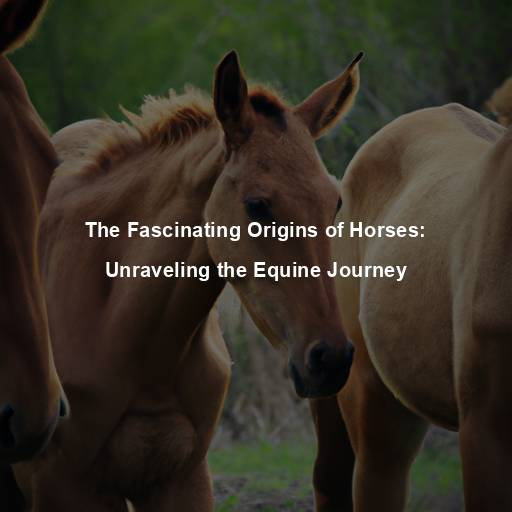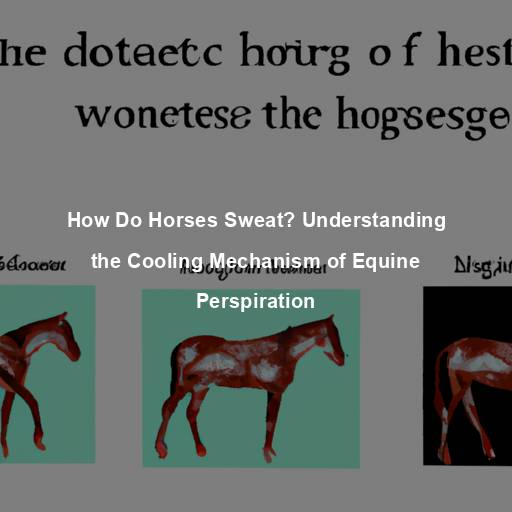The Fascinating Origins of Horses: Unraveling the Equine Journey
Last Updated on October 23, 2023 by Evan
Contents
- 1 Exploring the Ancestry of Horses
- 2 The Extinct Equine Relatives
- 3 A Profound Partnership
- 4 Guardians of Equine Heritage
- 5 FAQs – What did horses originate from?
- 5.1 Where did horses originate from?
- 5.2 How did horses evolve over time?
- 5.3 When did horses spread to other parts of the world?
- 5.4 What role did domestication play in horse evolution?
- 5.5 Are there any wild horses left today?
- 5.6 How have horses been important to human civilization?
- 5.7 Can horses still be found in the wild in North America?
Exploring the Ancestry of Horses
The Enigmatic Beginnings of Equines
Horses, majestic creatures that have captivated humans for centuries, have a remarkable story to tell. To truly comprehend their journey, we must delve into the depths of time and explore the origins of these magnificent animals. The ancestry of horses is a fascinating tale that spans millions of years, taking us back to a time when the world was vastly different.
The Dawn of Equidae
Step back in time and journey to a world where majestic creatures called horses were yet a distant dream. It is in the depths of history, over 55 million years ago, that the roots of these equine beings sprouted. Picture a diminutive mammal named Eohippus, affectionately nicknamed the “dawn horse,” gracefully navigating the North American woodlands, standing proudly at a mere 12-20 inches tall. These incredible beings, their lineage shrouded in mystery, captivate our imaginations as we uncover the mesmerizing tapestry of their evolutionary journey.
An Evolving Family
Throughout the eons, the magnificent horse has undergone a mesmerizing dance with time, waltzing through the corridors of evolution. As the pages of history turned, these majestic creatures faced formidable challenges, leading to a metamorphosis that defied expectations. Their gradual evolution saw them emboldened, stretching their bodies to towering heights and adorning themselves with the unmistakable traits that we now associate with the contemporary equine marvel.
The Mighty Mesohippus
In a fascinating twist of time, approximately 40 million years in the past, an enigmatic addition emerged within the equine lineage – Mesohippus. Appearing akin to a diminutive canine companion, this incredible being boasted an intriguing limb configuration, featuring three toes on its frontal appendages, and an intriguing hoof-like formation on its hind limbs. Flourishing amidst the luxuriant grassy plains of North America, Mesohippus not only captured the essence of the equestrian evolutionary narrative but presented a seminal leap forward in their captivating chronicle.
The Rise of the One-Toed Equus
Fast forward to approximately 5 million years ago, and we encounter the emergence of the genus Equus, which includes the horses we are familiar with today. Equus heralded a significant transition, as these ancestors of modern horses evolved to have one large toe on each foot, equipped with a strong hoof. This adaptation proved instrumental in their survival, allowing them to traverse various terrains with agility and speed.
Unraveling the Horse Family Tree
The Extinct Equine Relatives
Diving into the Depths of Time
As we explore the family tree of horses, we come across intriguing branches that lead to extinct equine relatives. These fascinating creatures, although no longer present, played a crucial role in shaping the equine lineage.
The Mighty Megaherbivores
Travel back in time, to a period shrouded in mystery and fascination – the late Miocene epoch, a time when the Earth’s landscapes were populated by a captivating variety of equine species. Among these magnificent creatures, one stands out in sheer size and strength – the awe-inspiring Megaherbivores. Imagine beholding these colossal herbivores, akin to modern-day rhinoceroses, gracefully roaming the North American grasslands. Equipped with their elongated limbs and formidable jaws, they effortlessly feasted on the lush vegetation that thrived around them, leaving us spellbound by their unique adaptation.
The Graceful Grazer: Equus Scotti
Step back in time to the enigmatic Pleistocene epoch, when the British Isles fluttered with the presence of an intriguing equine species known as Equus Scotti. These magnificent creatures, reminiscent in size to their modern-day counterparts, morphed into an extraordinary sight with their unique physical attributes. With their solid stature, formidable limbs, and a luscious mane that crowned their resolute forms, Equus Scotti truly embodied the epitome of adaptation to the unforgiving landscapes that they called home.
The Enigmatic Equus Ferus
In the vast expanse of the Eurasian steppes, a magnificent beast known as Equus ferus once reigned supreme. With its dun-colored coat and sturdy frame, it was a marvel of adaptation in the face of a harsh and unpredictable environment. Alas, the tale took a somber turn in the late 19th century, as the wild horse vanished from the world stage, leaving behind only the lingering echoes of its extraordinary existence.
The Impact of Horses on Human Civilization
A Profound Partnership
An Enduring Bond
The connection between horses and humans is not merely one of utility; it is a profound partnership that has shaped the course of history. From the earliest civilizations to the modern era, horses have played an integral role in transportation, warfare, agriculture, and sport.
The Horse-Powered Revolution
Across the annals of time, an extraordinary creature has held the reins of human destiny. With the dawn of civilization, horses stormed onto the stage, reshaping the very fabric of society. Their taming, some four millennia ago, wove together daring trails of triumph and paved the way for vast trade networks and sprawling empires. With their thundering hooves, these majestic beasts became indomitable forces on the battlefield, propelling warfare into uncharted territories of speed, power, and boundless maneuverability, forever indelibly etching their hoofprints upon the tapestry of history.
The Agricultural Advancement
In the fascinating realms of yesteryears, where the tapestry of life unraveled in agrarian harmony, a noble beast reigned supreme – the mighty horse. With sinewy muscles rippling and veins pulsating with unfathomable strength, these majestic creatures effortlessly transformed the very fabric of existence. As they plowed the fertile earth, hauling weighty burdens with unwavering resolve, and transporting precious cargo across vast distances, they became the fulcrum upon which the wheels of progress turned. The undeniable synergy between their boundless stamina and unyielding resolve propelled communities towards unfathomable heights of productivity and prosperity.
The Equestrian Pursuits
Throughout history, the ethereal allure of horses transcends their utilitarian role, captivating human hearts through a myriad of equestrian endeavors. From the hallowed grounds of the ancient Olympic Games to the pulsating arenas of contemporary horse racing, these magnificent creatures have reigned supreme, embodying an enchanting amalgamation of elegance, strength, and an unwavering zest for competition.
Preserving the Legacy of Equines
Guardians of Equine Heritage
The Need for Conservation
As we delve into the captivating tale of horses and their extraordinary influence on human civilization, the pressing need to safeguard their enduring legacy looms before us. In today’s complex world, horses encounter an array of formidable hurdles, encompassing the loss of their natural habitats, excessive exploitation, and the gradual erosion of their genetic makeup. As custodians of their majestic existence, it falls upon us to tread the path of stewardship, secu
Conservation Efforts
Across the globe, a wide array of passionate organizations and initiatives breathe life into the noble cause of preserving horses and their precious habitats. Bolstering this collective mission are meticulously crafted programs that encompass breeding, restoration of habitats, and thought-provoking campaigns to foster public awareness. In this united front, we delve into safeguarding the exquisite tapestry of genetic diversity and ecological equilibrium that these majestic creatures gift our cherished planet.
Education and Advocacy
In the grand tapestry of our world, there exists a realm where education and advocacy intersect, embarking on a profound journey to illuminate the magnificence and precariousness of equine existence. Within this ethereal realm, resides a resounding truth – the significance of horses and their preservation. It is only through the harmonious dance of responsible stewardship, compassionate treatment, and a profound reverence for these majestic creatures that we can unveil a luminous path toward forging a new era of equine enlightenment. Let us embrace this noble pursuit, as we kindle a flame within hearts, young and old alike, igniting a passion that shall forever echo in the annals of history – a resounding ode to the unwavering spirit of our equine counterparts.
A Lasting Legacy
Unraveling the enigmatic and captivating journey of horses unveils a tapestry woven with the wonders of evolution and the intricate interconnections that define life itself. From the obscure realms of dense forests to the breath-taking vistas of open plains, horses have undergone a mesmerizing transformation to become the quintessential symbols of grace and power that we marvel at today. In a world brimming with perplexity, let us embrace the true essence of these majestic creatures, safeguarding their legacy for the generations that follow, and allowing their incredible narrative to continue captivating our hearts and minds.
Exploring the Ancestry of Horses
The Enigmatic Beginnings of Equines
Horses, the majestic creatures that have captured the hearts and imaginations of humans for centuries, have a truly remarkable story to tell. To truly comprehend their journey, we must delve into the depths of time and explore the origins of these magnificent animals. The ancestry of horses is a fascinating tale that spans millions of years, taking us back to a time when the world was vastly different.
The Dawn of Equidae
Discover the mesmerizing origins of horses as we delve into their prehistoric past. Step back in time and explore the ancient woodlands of North America, where a fascinating creature named Eohippus, or the “dawn horse,” once roamed. Measuring just a mere 12-20 inches in height, this small mammal was the ultimate predecessor to the majestic equines we know today. Join us on a journey through 55 million years of evolution and unlock the secrets of these enigmatic creatures.
An Evolving Family
Throughout the eons, the captivating saga of equine evolution has unfolded, a mesmerizing tale of resilience and adaptation in the face of ever-shifting landscapes. Over countless millennia, these magnificent creatures, tracing their ancestry back to the mists of time, embarked on an extraordinary journey of transformation. Diverse and bewildering, this epic narrative witnessed their metamorphosis into the majestic giants we recognize as the horses of today, as they deftly embraced and embraced the defining hallmarks of their kind.
The Mighty Mesohippus
Step back in time, about 40 million years ago, and you’ll find yourself in the presence of an enigmatic character – Mesohippus. Imagine a creature resembling a small dog, yet with a unique twist: three toes on its front legs and a curious hoof-like structure on its hind limbs. Thriving amidst the abundant green landscapes of North America, Mesohippus played a vital role in the evolution of the equine family, leaving researchers buzzing with fascination and questions about its mysterious past.
The Rise of the One-Toed Equus
FAQs – What did horses originate from?
Where did horses originate from?
Did you know that horses have a long and intriguing history that dates back more than 55 million years? It all began in North America, where the first known horse ancestor, known as Eohippus or Hyracotherium, roamed the land. Picture this tiny creature, roughly the size of a dog, navigating the lush forests with its unique foot structure – four toes on its front feet and three on its hind feet. It’s fascinating to imagine how horses have evolved and thrived over the ages, capturing our awe and admiration along the way.
How did horses evolve over time?
Over millions of years, horses went through a gradual process of evolution, adapting to the changing environment. They evolved from small, browsing animals to large, grazing animals with longer legs and fewer toes. The development of a single hoof on each foot allowed them to run faster and more efficiently. In addition, their teeth and digestive systems adapted to a diet of grass and other coarse plants.
When did horses spread to other parts of the world?
Throughout history, horses embarked on incredible journeys, surging across vast landscapes with both determination and marvel. It is said that these majestic creatures embarked on an epic voyage from North America to Asia, defying the odds and traversing a land bridge that emerged around 2-3 million years ago, creating an intercontinental connection that forever altered their destiny. As time pressed on, the horses’ captivating expedition continued onward, captivating Europe and Africa, as they adapted to the ever-changing climate and sought out ideal environments to thrive amidst the perplexing tapestry of our world.
What role did domestication play in horse evolution?
The domestication of horses occurred around 5,500 years ago, mainly in the Eurasian steppes. This domestication process greatly influenced their evolution and the development of different horse breeds. Through selective breeding, humans selectively bred horses for specific traits, such as strength, speed, or endurance. This led to the development of various horse breeds that we see today.
Are there any wild horses left today?
Wild horses are a captivating sight, their untamed spirit a testament to the enduring grace of the equine world. One cannot help but be intrigued by the enigmatic mustangs of North America, whose bloodlines date back to domestic horses that dared to break free. Equally mesmerizing are the Przewalski’s horses, also known as Mongolian wild horses, their existence serving as a poignant reminder of an ancient heritage. These elusive creatures inhabit remote corners of the world, embodying the delicate balance between humanity and the raw, untamed forces of nature.
How have horses been important to human civilization?
Throughout the annals of time, the majestic presence of horses has been intertwined with the very fabric of our human civilization. Their hoofbeats have echoed across the ages, leaving us in awe of their strength, grace, and versatility. From the moment mankind harnessed their power, horses swiftly carried us towards progress, opening untrodden paths and pushing the boundaries of our existence. Whether it was the groundbreaking speed and efficiency they brought to transportation, the unyielding strength they lent to agriculture, or the awe-inspiring might they bestowed upon warrior cavalry, horses bewilderingly transformed our world. Even in contemporary times, these enchanting creatures continue to captivate and mesmerize, offering us moments of sheer joy and respite through activities such as horseback riding, exhilarating races, and the therapeutic bond they forge with our souls.
Can horses still be found in the wild in North America?
No, horses are currently not found in the wild in North America. The wild horse populations that exist today are descendants of domesticated horses. There were once an abundance of wild horses in North America, but their numbers declined due to hunting, habitat loss, and competition with livestock. Some efforts are underway to reintroduce wild horses to certain areas, but it is a complex and controversial topic.







